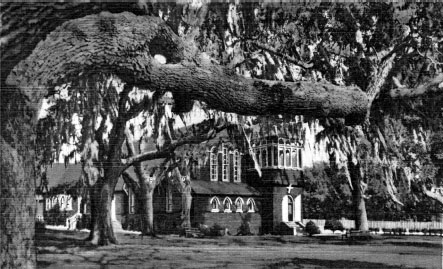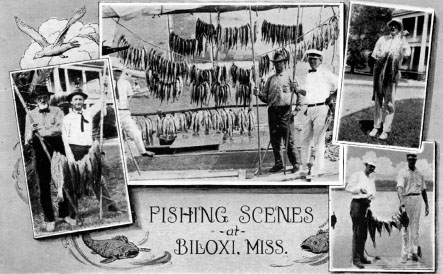Legends and Lore of the Mississippi Golden Gulf Coast (8 page)
Read Legends and Lore of the Mississippi Golden Gulf Coast Online
Authors: Edmond Boudreaux Jr.

By the 1940s, we begin to see the legend as it is known today begin to evolve. As long as humans have been communicating, there have been stories and legends like these. Along Mississippi's Golden Gulf Coast, it is no different, and the tales get taller down the line. Like all local legends, the story is ultimately in the hands of the storyteller.
CHAPTER 10
T
HE
I
NDIAN
L
EGEND OF THE
R
ING IN THE
O
AK
The oak with its ring still stands today near Bellman Street and Beach Boulevard. Until Hurricane Camille destroyed the Episcopal Church of the Redeemer rectory, the Ring in the Oak stood directly in front. Of course, one will find many versions of a so-called Indian legend of how the ring came to be in this live oak. All agree that the daughter of the Biloxi Indian chief had fallen in love with a warrior of another tribe. The most common legend indicates that the warrior was a Pascagoula Indian and that the Pascagoulas were the enemy of the Biloxis. The chief told the young couple that not until a ring appeared in the oak would he allow them to marry. A storm of hurricane force hit that evening, and in the morning, a ring appeared in the oak. The Biloxi chief honored his word and allowed his daughter to marry the Pascagoula warrior. While a great love story, we know from historical records that the Biloxi and Pascagoula Indians were not only allies but also friends. Still, this legend stands as a true testimony to the power of love.
The earliest account of the legend appeared in 1896, when the
Daily Herald
published a book titled
Legends and Lyrics of the Gulf Coast
, by Laura F. Hinsdale. Included among her thirty-two poems was one titled “The Live Oak Ring.” In Hinsdale's verses, we find the Biloxi chief's daughter.
Twas here she grew, flower of the wild
A maiden of Biloxi's race, a chieftain's fair and only child
.

The Ring in the Oak and the Episcopal Church of the Redeemer, Biloxi.
Courtesy of Alan Santa Cruz Collection
.
Hinsdale indicates that many had sought “a glimpse of her sweet face.” Finally, into the story enters a Natchez warrior of noble descent.
The warrior sought the chieftain's side, a Natchez ring he bore
He asked the maiden for his bride, to leave his side no more
.
Of course, the Biloxi chief stated his conditions:
When a ring grows on yonder tree, and circles yonder bough
Then you may bear my child from me, and wed with ring and vow
.
Enter Mother Nature with a strong storm, causing “two branches twined into a ring.” So this version of the legend has it beginning with a Biloxi maiden and Natchez warrior.
Who was Laura F. Hinsdale? Mrs. Hinsdale was married to Dr. Robert Hinsdale, pastor of the Episcopal Church of the Redeemer. Dr. and Mrs. Hinsdale served the church from 1883 to 1889. After Dr. Hinsdale's death on January 9, 1889, Laura Hinsdale continued to live in Biloxi.
It is here on the old church grounds that the Ring in the Oak stands to this day. Previously the two main characters in this story were the Biloxi chief's daughter and a noble Natchez warrior. Today's legend has a Biloxi chief's daughter and a Pascagoula chief's son. So when did we arrive at today's legend?

A Pascagoula warrior and Biloxi Indian maiden.
Edmond Boudreaux
.
On July 5, 1925, the legend took a different twist. Josephine Wilkes, daughter of Eugene Wilkes and Loretta Voivedich, wrote a letter to the “Aunt Jane” column in the
New Orleans Times-Picayune
. In Josephine's letter, she told her version of the Ring in the Oak. “The Indian prince was the son of the tribe of Indians who inhabited Biloxi, while the princess was the daughter of an Indian chief who lived on Deer Island.” While we have no tribes named, the legend remained basically the same.
Over time, the legend continued to evolve. There is a version that refers to the maiden as “the young fawn” and has the tribe living in wigwams. If we look at history, the wigwam was used mainly on America's western plains. There is also the version where the “Terrible Thunder God” caused the ring to form, and the scared chief, fearing his wrath, allows the young lovers to marry.
Then on December 6, 1936, the legend takes its present-day form. The
Times-Picayune
reported, “Ring in Tree Unites Tribes.” The reporter indicated that she personally loved Indian legends and began to weave the story of hate between the Biloxis and Pascagoulas and the love of the young couple that finally united both tribes. This is the legend we know, a true testimony to the power of love uniting lovers and creating peace between two enemies.
Mrs. Laura F. Hinsdale died on December 11, 1925, at seventy-seven years of age. Both Laura and Robert Hinsdale are buried in the Biloxi Cemetery. She is considered a Mississippi poet and writer. Her book,
Legends and Lyrics of the Gulf Coast
, can be found in the Historical Wing of the Biloxi Library. Little did she know that her poem “The Live Oak Ring” would become a legend for all times, passed from generation to generation.
While the Ring in the Oak is a freak of nature, it has attracted considerable interest from tourists and locals alike. Adding the historic and romantic Indian legend just makes it more appealing to all.
CHAPTER 11
W
EAVING A
T
ALL
T
ALE
We all know of at least one person who can weave a tall tale. Some folks have natural abilities in the art of storytelling, while others have to work hard to pull it off. On September 14, 1903, the
Biloxi Herald
published an article titled the “Tchoutacabouffa.” The author listed himself as “Filet De Treit Vert.” The French spelling was a little off and should have been Filet de Truite Verte or translated “Filet of Green Trout (Bass).” Though we may never know the identity of the author, his sense of humor and his very tall tale make for an interesting story.
The tale begins with historical facts about the development of the seafood industry in Biloxi, stating that the advancements have positioned the “seaside resort to that of a growing commercial mart.” The author continued with a description of Biloxi as a peninsula surrounded by water from the Gulf and Back Bay. Yet nearby is the Tchoutacabouffa River, teeming with various species of fishâa virtual fisherman's paradise.
Here is where the tall tale begins. The writer says that the river is “closely and dramatically linked with Biloxi in rich past historical association.” During the French Dominion, he states that Governor La Tour (though in actuality, La Tour was never the governor of French Louisiana) had complained of the Spanish danger to Biloxi. La Tour reported that cannons surrounded Biloxi on all sides. Some were up the Tchoutacabouffa River, which caused La Tour's troops to be overextended. The practice of firing the cannons on the Tchoutacabouffa caused fish kills that were dangerous to public health, so he moved the cannons to the peninsula. La Tour then doubled his line of defense, thus causing his troops to be “over tacked.” In historical text of French occupation of Biloxi's peninsula, the primary defenses focused on an attack from sea.

Courtesy of Alan Santa Cruz Collection
.

Fishing near the Tchoutacabouffa River, Biloxi.
Courtesy of Alan Santa Cruz Collection
.
The writer continued with the Spanish Period, from which he related a curious reference of how Biloxi was saved by the Tchoutacabouffa. It seems the Indians had surrounded Biloxi, but fearing the Spanish cannons, they set a siege to starve the Spanish into submission. As the garrison neared starvation, “some expert fishermen got into buggies, general about 2 o'clock in the afternoon, slipping through the woods with marvelous ability and dexterity proceeded to the Tchoutacabouffa and caught such immense numbers of green trout and other fish,” saving the Spanish garrison. There is just one problem with this miraculous saving of the garrison: the Spanish never had a garrison post in Biloxi. The author also failed to indicate how the siege ended. It is also interesting to note that the fishermen slipped out of the Indian-surrounded fort in broad daylight, let alone how they slipped back in with buggies loaded with fish.
The author continued with what he called the Commandant Didier's administration. The writer said that in 1710, a severe winter visited Biloxi with several feet of snow. Yes, he wrote several feet of snow! The gulf was frozen enough to walk to Deer Island, all communication was stopped and the city was facing starvation and a lack of firewood. Ah, yes, the fishermen to the rescue! With cast nets, hooks and line (but no bait), the fishermen journeyed to the Tchoutacabouffa. It's unclear whether they walked there on the frozen ice, but of course they returned with “an immense score of fresh fish and transported it to a primitive log warehouse” situated at about the site of Swetman's Drugstore in 1903. Here they divided the fish according to size. Some they cured as food, some became fuel and others that were “liberally subjected to alcoholic treatments served in the place of candles and lamps during the long dark winter nights.” Little did we know the many uses of fish or that several feet of snow had ever fallen on the Mississippi Golden Gulf Coast!
The writer then moved to the American period and a famous duel on the Tchoutacabouffa. He said that a celebrated Indian chief and a trapper had both fallen in love with a beautiful Indian maiden. She was having difficulty choosing between then, so the Indian chief and the trapper decided on a fishing contest to settle their quest. They would both wade into the Tchoutacabouffa River up to their chins and string the fish around their necks. Fishing from sunrise to sunset, the one who caught the greatest quantity would be the winner. Unfortunately, the Indian strung large fish while the trapper only strung smaller fish. As sunset neared, the exhausted Indian “sank down into the waters and was drowned, leaving the trapper the triumphant victor.” The writer concluded that his long, winding tale is the reason Biloxi should be beholden to the Tchoutacabouffa River.
